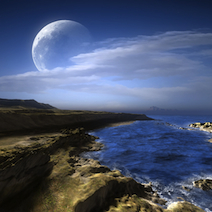A team of researchers explored the possibility of giant impacts on Earth-like planets resulting in a Moon-like satellite: according to their simulations, the phenomenon may be much more common than previously thought.
In the most popular scenario, our Moon formed after Earth and another planet collided: over time, the debris produced by the titanic collision coalesced and gave birth to our planet’s satellite. Sebastian Elser and his colleagues have now run computer simulations to calculate the probability of having Moon-like satellites orbiting Earth-like planets.
Their results are very interesting: according to their simulations, the odds of such a scenario are somewhere between 1 in 6 and 1 in 45. Even with the low-end estimate, this gives quite a large number of planets with an orbiting moon!
The motivation behind this study is actually the search for habitable exoplanets. Indeed, a planet orbiting its parent star in the habitable zone is a first requirement, but it is far from being enough to label an Earth-like planet “habitable” (especially that the concept of habitable zone is still far from being clearly defined). Theoretically, this would allow the presence of liquid water on a planet’s surface; another important ingredient for the emergence and the evolution of life is a stable climate.
This is where massive moons play a major role. Global climate is mostly influenced by the distribution of solar insolation. While the annual-averaged insolation on the surface of a planet is related to the distance to the parent star, it is also strongly linked to obliquity – the angle between an object’s rotational axis and the normal of its orbital plane. Without the Moon, the Earth’s obliquity would undergo very large and chaotic variations, with dramatic consequences for global climate: a Moon-like satellite orbiting an Earth-like planet would considerably help stabilizing the planet’s obliquity, thus increasing the chances for life to emerge and evolve.
Of course, there are many variables to take into account in such studies, and more research has to be done. Finally, if these results are confirmed, this could be another sign that after all, life might exist somewhere else, and might not be so rare in our vast Universe.
Image: “Tide pools of Azimech” by moodflow


